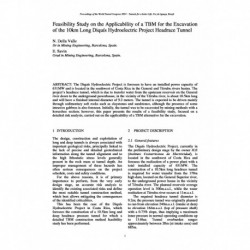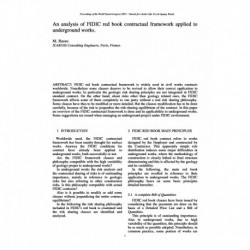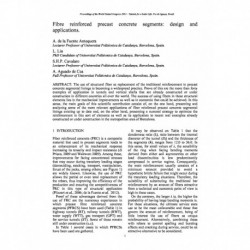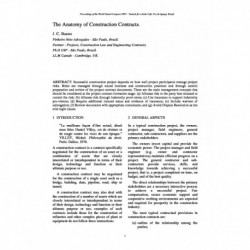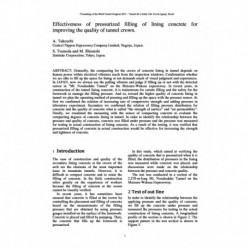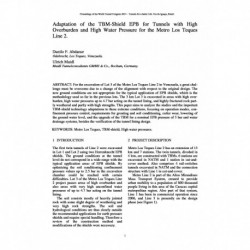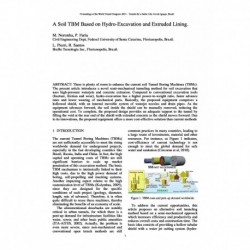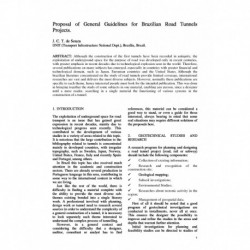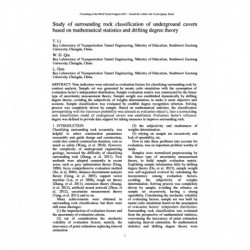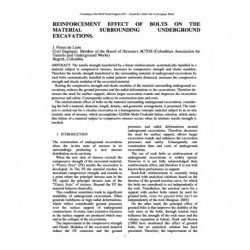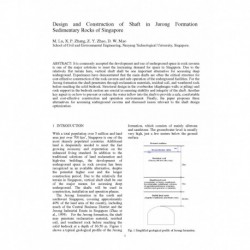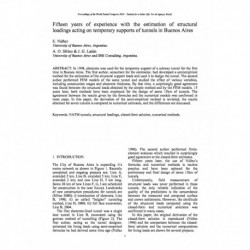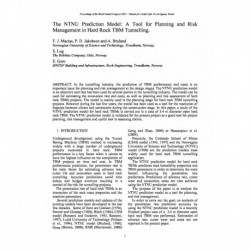No document
Search & filter
Search for a publication
Search & filter
World Tunnelling Congress
WTCThere are 1984 documents.
-
Feasibility Study on the Applicability of a TBM for the Excavation of the 10km Long Diquís Hydroelectric Project...
Abstract: The Diquís Hydroelectric Project is foreseen to have an installed power capacity of 631MW and is located in the southwest of Costa Rica in the General and Térraba rivers basins. The project’s headrace tunnel, which is due to transfer water from the upstream reservoir on the General river down to the underground powerhouse, in the vicinity of the Térraba river, is about 10.5km long and will...
0,00 € -
An analysis of FIDIC red book contractual framework applied to underground works
Abstract: FIDIC red book contractual framework is widely used in civil works contracts worldwide. Nonetheless some clauses deserve to be revised to allow their correct application to underground works. In particular the geologic risk sharing principles are not integrated in FIDIC standard contract. On the other hand, about risks other than geology related ones, the FIDIC framework affects some of them...
0,00 € -
Fibre reinforced precast concrete segments: design and applications
Abstract: The use of structural fiber as replacement of the traditional reinforcement in precast concrete segmental linings is becoming a widespread practice. Prove of this are the more than forty examples of application in tunnels and vertical shafts that are already constructed or under construction in different countries all over the world. The success of using fibers in these structural elements lies...
0,00 € -
The Anatomy of Construction Contracts
Abstract: Successful construction project depends on how well project participants manage project risks. Risks are managed through sound business and construction practices and through careful preparation and review of the project contract documents. There are the main management concepts that should be considered at the project contract formation stage: (a) Allocate risk to the party best situated to...
0,00 € -
Effectiveness of pressurized filling of lining concrete forimproving the quality of tunnel crown
Abstract: Generally, the compacting for the crown of concrete lining in tunnel depends onhuman power within electrical vibrators reach from the inspection windows. Confirmation whetherwe are able to fill up the space for lining or not demands much of visual judgment and experiences.In JAPAN, now we always use the pulling vibrator and judge if filling up or not with the detectedsensor in “Mt. Nosakadake...
0,00 € -
Adaptation of the TBM-Shield EPB for Tunnels with High Overburden and High Water Pressure for the Metro Los Teques...
Abstract: For the excavation of Lot 3 of the Metro Los Teques Line 2 in Venezuela, a great chal-lenge must be overcome due to a change of the alignment with respect to the original design. The new ground conditions are not appropriate for the typical application of EPB shields, which is the methodology used so far in the previous lots. The 3 km Lot 3 is excavated in areas with high overburden, high water...
0,00 € -
A Soil TBM Based on Hydro-Excavation and Extruded Lining
Abstract: There is plenty of room to enhance the current soil Tunnel Boring Machines (TBMs). The present article introduces a novel semi-mechanized tunneling method for soil excavation that uses high-pressure waterjets and concrete extrusion. Compared to conventional excavation tools (fracture, friction and wear), hydro-excavation has a higher power-to-weight ratio, faster advance rates and lower wearing...
0,00 € -
Proposal of General Guidelines for Brazilian Road Tunnels Projects
Abstract: Although the construction of the first tunnels have been recorded in antiquity, the exploitation of underground space for the purpose of road was developed only in recent centuries, with greater emphasis in recent decades due to technological explosion seen in the world. Therefore, several publications on many subjects has emerged, especially in countries with greater financial and...
0,00 € -
Logistics of Limited Space Urban Tunnelling at Singapore’s Mega Metro
Abstract: Today’s mega metro projects are using multiple TBMs in difficult ground, short tunnels, and in urban settings: Factors that create unique challenges. At Singapore’s metro construction, 21 km of tunnel for the Downtown Line 3 are underway using 29 TBMs boring between 16 station sites in short bores often less than 1.5 km each. By 2017, 39 km of new construction will cut commute times in half in...
0,00 € -
Study of surrounding rock classification of underground cavern based on mathematical statistics and drifting...
Abstract: Nine indicators were selected as evaluation factors for classifying surrounding rock by contrast analysis. Sample set was generated by monte carlo simulation with the assumption of evaluation factor’s independent distribution. Sample evaluation matrix was constructed by the linear type of uncertainty measurement theory. Sample weight was established dynamically by drifting degree theory,...
0,00 € -
Reinforcement effect of bolts on the material surrounding underground excavations
Abstract: The tensile strength transferred by a linear reinforcement, systematically installed in a material subject to compressive stresses, increases its compressive strength and elastic modulus. Therefore the tensile strength transferred to the surrounding material of underground excavations by steel bolts systematically installed in radial patterns uniformly distanced, increases the compressive...
0,00 € -
Design and Construction of Shaft in Jurong Formation Sedimentary Rocks of Singapore
Abstract: It is commonly accepted the development and use of underground space in rock caverns is one of the major solutions to meet the increasing demand for space in Singapore. Due to the relatively flat terrain here, vertical shaft shall be one important alternative for accessing deep underground. Experiences have demonstrated that the main shafts are often the critical structure for cost-effective...
0,00 € -
Use of 3D Scanning Technology for Automated Inspection of Tunnels
Abstract: Significant advances in high-speed 3D imaging technology have been made in the last decade and there are now commercial, off-the-shelf, solutions for automatically evaluating infrastructure condition at high-speed. One such device is the Laser Tunnel Scanning System (LTSS) developed by Pavemetrics; a “spin-off” of the National Optics Institute of Canada. The LTSS system utilizes high-speed...
0,00 € -
A numerical study of the disc cutter behaviour while cutting hard rocks
Abstract: The present study investigates the structural behavior of the disc cutter as well as the local behavior, namely stress-strain evolution within the rolling disc cutter while cutting a hard rock block, which is directly related to the disc cutter degradation. The investigation has been carried out using a 3D numerical model in the commercial Finite Element code LS-DYNA. The influence of various...
0,00 € -
Fifteen years of experience with the estimation of structural loadings acting on temporary supports of...
Abstract: In 1998, shotcrete was used for the temporary support of a subway tunnel for the first time in Buenos Aires. The first author, consultant for the contractor, had developed a semiempirical method for the estimation of the structural support loads and used it to design the tunnel. The second author performed FEM models of the same tunnel and studied the effect of various variables,...
0,00 € -
The NTNU Prediction Model: A Tool for Planning and Risk Management in Hard Rock TBM Tunnelling
Abstract: In the tunnelling industry, the prediction of TBM performance and costs is an important issue for planning and risk management at the design stages. The NTNU prediction model is an objective tool that has been used by several parties in the tunnelling industry. The model can be used for estimating the excavation rate and costs, as well as planning and risk assessment of hard rock TBMs projects....
0,00 €

